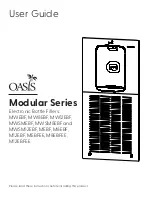
same size as the pump inlet or sized
based on reasonable fluid friction
losses.
A foot valve is recommended when
lifting fluid from a sump. This will
save wear and tear on any pump,
even those equipped with self-prim-
ing equipment.
A suction strainer is recommended
immediately ahead of the pump on
any newly constructed system. This
is advisable due to the probability
that foreign material large enough
to damage pump clearances may
remain even though the piping has
been flushed.
Valves in the outlet piping of a regen-
erative turbine pump should always
be open as far as possible when the
pump is started. This will reduce
the start-up load on the pump and
motor. Never start the pump with the
discharge valve closed.
Inlet valving should be open when
starting any pumping system. With-
out some fluid in the pump, it can gall
and lock up impellers. Violent pump
failure will result from continued
operation with the inlet or discharge
valve closed.
1D4 Priming
Regardless of whether self-priming
equipment is used or not, always fill
the pump and vent it of air for best
seal and pump life. Under most
circumstances, regenerative turbine
pumps can be made to self-prime as
long as a small amount of fluid can
be recirculated through the impeller
and the fluid doesn’t heat up notice
-
ably.
1D5 NPSH (Net Positive Suction
Head)
The NPSH required varies with every
size and capacity of pump and gener-
ally comes into consideration when
the fluid being pumped approaches
its vapor pressure or boiling point.
The NPSH requirements of regen-
erative turbine pumps are different
from centrifugal pumps in that there
is no single specification for a given
unit. The pump curve of head vs.
capacity will vary according to the
NPSH available, but does not have a
minimum requirement like a centrifu-
gal. The performance of each unit at
a given NPSH can be obtained from
the performance curves or from your
MTH representative. Understanding
this, we can say that there will be a
minimum NPSH required to obtain a
specific performance from a unit ac
-
cording to its NPSH curves.
If the NPSH Available (NPSHA) is not
equal to or greater than that required
by the pump (NPSHR), it must be in-
creased or a different pump selected.
The usual method for increasing
NPSH is to raise the static head on
the pump inlet, (H
s
) by raising the
source tank or lowering the pump.
By definition, NPSH means: “Net
Positive Suction Head” above the
vapor pressure of the pumped
liquid available at the centerline
of the pump. It should always be
given in feet of pumped liquid. The
NPSH is actually a measurement
of the amount of energy available
in the pumped liquid to produce the
required absolute entrance velocity in
the pump. If a pump requires more
energy (or NPSH) than is available at
a given capacity, the pressure at the
inlet will fall below the vapor pres-
sure of the pumped liquid, and loss of
performance will result. The NPSH
available may be calculated using the
following equation.
NPSHA = 2.31( )+ H
s
- H
f
P
s
= Pressure in the suction vessel
in PSIA.
P
vp
= Vapor pressure of the pumped
fluid in PSIA.
H
s
= Static height of the pumped fluid
above (+) or below (-) the centerline
of the pump.
H
f
= All friction losses from the vessel
to the pump including pipe, valve,
and suction strainer friction.
For boiling liquids, P
s
and P
vp
are
equal, this term then becomes zero,
and can then be omitted from the
equation. Please refer to the Hy-
draulic Institute Standards and fluid
friction loss tables for more informa-
tion on this subject.
1D6 Noise
While not generally considered
especially noisy, regenerative turbine
pumps often produce a high pitched
whine that increases in intensity as
the differential pressure produced
in the pump increases. While high
frequency sound is attenuated more
easily than lower frequencies, piping
structures and the fluids in them
readily transmit and even amplify
noise. Motors, bearings, and other
rotating components add to noise
and sometimes create objectionable
harmonics.
Careful pump installation can con-
tribute to noise reduction. Proper
alignment of the pump and driver is
essential.
Adequate supports for the inlet and
discharge piping are equally impor-
tant. A degree of noise reduction
may be obtained when the pump-
ing unit is supported free of building
structures by the use of vibration
isolators, flexible piping and conduit
connections. Elastomer type cou-
plings are the best choice to separate
motor noises from the fluid and piping
structure.
1D7 Freezing
When ambient temperatures drop be-
low the freezing point of the fluid in a
pump, consideration should be given
to heating, insulating, or draining the
pump. If you choose draining, and
it will only be for a short period, first
remove the drain plugs and drain the
lines to and from the pump. Carefully
blow out the pump with compressed
air to clear all internal cavities of fluid.
DO NOT use automotive anti-freeze
in pumps as the silicates present in
these fluids cause damage to me
-
chanical seals.
1E Recommended Spare Parts
FOR CRITICAL SERVICES - a
duplex installation, with two identical
pumping units in parallel, is the safest
and many times the most cost effec-
tive choice.
FOR IMPORTANT SERVICES - a
standby pump, ready for installation
is advised.
P
s
- P
vp
sp. gr.
Page 503


































